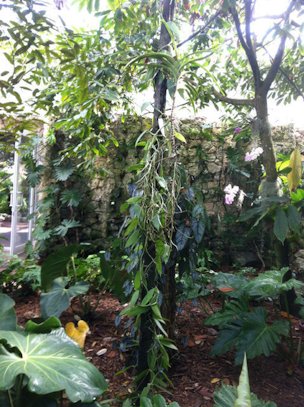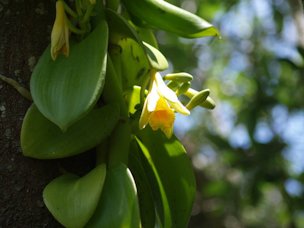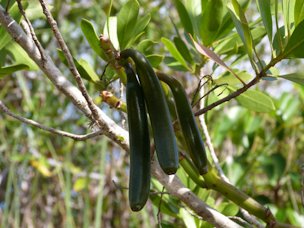From Fairchild
Tropical Botanic Garden
by Noris Ledesma Curator of Tropical Fruit
The Florida vanilla vine, ‘a big climbing orchid’
As published in the Miami Herald
The vanilla orchid is a tropical plant that grows in the humid
rainforests of Central and South America, Mexico, Tahiti and
Madagascar, with a few native species in Florida.
The Aztecs
discovered the plant in Mexico and used the seed pods in various ways:
to aid in digestion, as an aromatic, and to flavor beverages for
Emperor Montezuma. The Totonaca people of the Gulf Coast of Mexico were
probably the first people to domesticate vanilla. It was originally
believed to have value only as a perfume; its value as a flavoring for
food and drinks wasn’t discovered until later.

The vanilla vine at Fairchild Tropical Botanic Garden, "a big climbing orchid."
Vanilla planifolia
is one of more than 60 species of vanilla orchids that have been around
for almost 500 years. The vines grow up to 30 feet long, and the plant
takes seven to eight years to mature. The pale yellow or green flowers,
blooming from April to July, are just as unusual as the stems and the
form of this orchid. They open in the early morning and usually close
by midday. They are fragrant and attract bees, butterflies and birds.
Growing Vanilla orchid in South Florida
South Florida has a few native vanilla species that make usable pods: Vanilla phaeantha, Vanilla dilloniana, and Vanilla barbellata.
Unfortunately, these unusual native orchids are listed as endangered by
the state of Florida due to habitat destruction and over-collecting.
This plant is an epiphytic orchid native to moist hammocks, swamps, and
coastal mangrove swamps like those of southern Florida and the Florida
Keys. They are very rare, and collecting them is not allowed.
Fortunately, we have the option of growing the legendary vanilla orchid in our backyards. Several selections of Vanilla planifolia
that grow in South Florida are available in local nurseries. You can
start a plant from cuttings, using a mixture of sand and potting soil.
Set the cuttings deeply enough so that roots are covered, and insert a
wooden stake next to the plant so you can tie the plant to it for
support. Protect your plant by putting it in an area that gets indirect
sunlight and is away from cold drafts. The new plant needs warmth and
humidity.

Flowers are fragrant, and are attractive to bees, butterflies and birds.
Provide a support:
Vanilla orchids grow slowly until the roots develop, which can take up
to two months. The plants are beautiful on their own and also look
great climbing up trees in a tropical landscape.
Like other
members of this species, the plant begins growing terrestrially, but as
the base rots away, the plant becomes fully epiphytic. Carefully plant
it at the base of an existing tree. Oaks are wonderful hosts, but any
tree will work. Like all climbing plants, the vanilla vine needs
support to grow to its full height. The advantage of growing on a tree
is the shelter the tree provides from excessive exposure to the sun and
strong winds. The tree must have deep roots so that nutrition in the
upper soil layer, where the vanilla takes root, is not depleted.
In
their natural environment, vanilla orchids will climb some yards up the
tree, thanks to their climbing roots. The vine should be guided back to
the ground regularly to promote the growth of new roots in the soil.
This method provides an ample supply of nutrients and triggers fast
vegetative growth. It takes approximately three to five years after
planting for the vanilla vine to start blooming. When successful, the
flowers remain on the vine and a pod will develop.
This
particular vanilla needs water regularly. Cuban garden snails are the
biggest threat to their development. Control them by removing them. If
the problem persists, you can use salt to keep them away.
The
process of growing vanilla requires intensive agricultural management.
The fruits, which resemble large green beans, must remain on the vine
for nine months in order to completely develop their signature aroma.
They develop these distinctive properties during the curing and drying
process.

Vanilla beans hang from the vine.
Growing
vanilla is a big industry. Today, the orchids are grown in Mexico, the
Bourbon Islands, Tahiti, Indonesia, India, Uganda, and Papua New
Guinea. They are pollinated, harvested and cured by hand by farmers in
a process that takes anywhere from 13 to 14 weeks. After the seed pods
spend about nine months on the vine, the curing and aging process takes
a further three months before the beans are ready to be sold.
If
you’re one of those people who are up for a “green” challenge, then
consider growing and producing your own vanilla. It’s a rewarding
experience that will help you learn and appreciate the work involved in
its production. Start from your own cuttings, which are easy to
propagate, or you can find plants in local nurseries.
Back to
Vanilla Page
|
|


